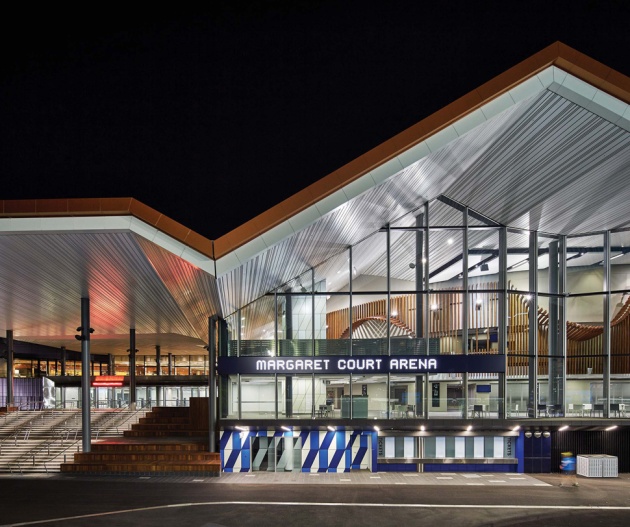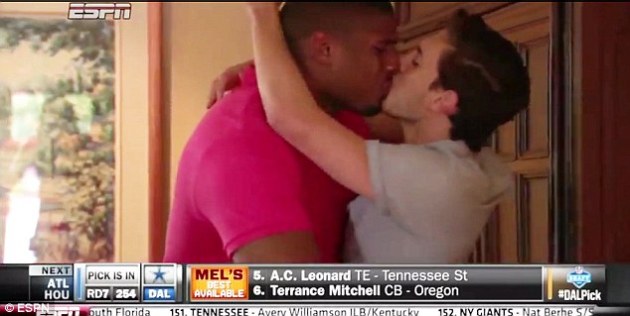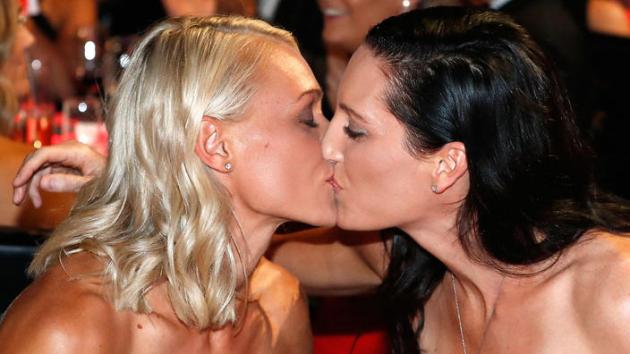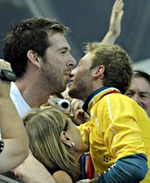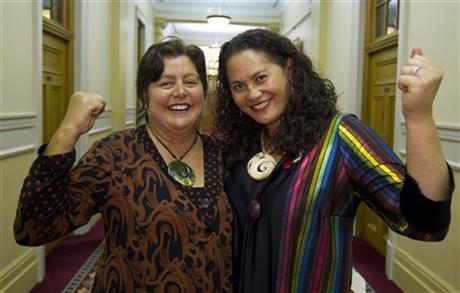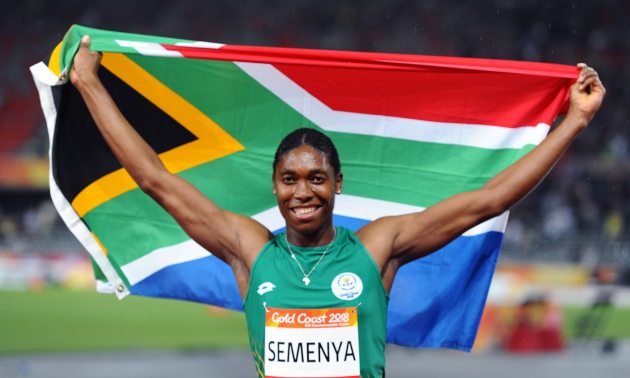As we enter the second week of the Australian Open, it is time, for yet another year, to call off the search party for that rare beast, the Australian singles quarter-finalist. Not seen since 2009, this critically-endangered animal is quickly going the way of its relative, the Australian winner, not seen since 1976 (male) and 1978 (female) respectively, and now presumed extinct.
But, believe it or not, there is at least one creature in tennis which is even rarer, indeed almost mythical – the openly gay or bisexual male tennis player.
In the long history of this genteel sport, there have been only two male tennis players of note who have been linked to homo- or bi-sexuality, and both had tragic personal stories. The first, 1930s German world number 1 and dual French Open winner, Gottfried Von Cramm, was jailed for 6 months by the Nazi regime for ‘morals charges’, as the result of an affair with another man.
The second, the great Bill Tilden of the US, the best player in the world in the 1920s and winner of 3 Wimbledons and 7 US Opens, was twice jailed after his career had finished for male same-sex encounters (one with a 14 year old sex worker and a second with a 16 year old hitchhiker – their respective ages certainly making this a more complicated case to ‘categorise’).
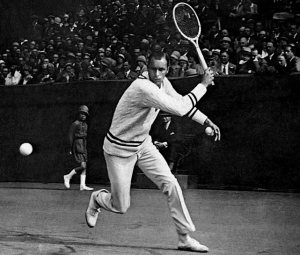
Bill Tilden. Source: Sports Illustrated.
There have been no openly gay or bisexual male players in the post-Second World War period, and certainly none of any note in the Open era.
Contrast this with the cavalcade of greats from the women’s game known to have been lesbian, bisexual or, at the very least, to have been in same-sex relationships. This includes greats like Helen Jacobs (winner of 5 grand slams); Billie Jean King (12 grand slams), who was famously outed through a ‘palimony’ lawsuit from an ex-partner; Martina Navratilova, winner of 18 slams who voluntarily came out in 1981 early in her career; and Hana Mandlikova, winner of 4 slams (and who, towards the end of her career, became an Australian citizen).
They are joined by some of the best doubles players of the past 30 years as well, including Gigi Fernandez (winner of 17 Grand Slam doubles titles and 2 Olympic gold medals), Lisa Raymond (6 Grand Slam doubles titles) and our own Rennae Stubbs, winner of 4 Grand Slam doubles titles and a 4-time Olympian.
Perhaps the most famous lesbian player of the past 15 years was Amelie Mauresmo, the Frenchwoman who made the Final of the Australian Open in 1999, and ‘came out’ at the same time, acknowledging her girlfriend Sylvie. All that, at 19 years of age (as an aside, it is worth noting that one of the players who, at least early in her career, had a reputation for being mentally fragile on the court, was incredibly strong off it). Mauresmo went on to become world number 1, and won both the Australian Open and Wimbledon Championships later in her career.
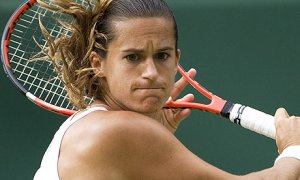
Amelie Mauresmo. Source: The Guardian.
In 2013, in a sign of how far the women’s tour has come, Australia’s Casey Dellacqua came out via a short statement announcing the birth of her and her partner Amanda’s son, Blake. About the only consequence of that announcement has been an increase in questions from reporters about how she manages life on tour with a new-born.
It is fair to say that, when a male player does eventually come out, it will provoke a much larger response, from the tennis community, the media and of course the fans. Unlike other sports, this will not necessarily be because men’s tennis is, in an inherently sexist view, deemed more important than the women’s game (because of the wonderful work of people like Billie Jean King, gender inequality is far less in tennis than elsewhere), but simply because the novelty of a men’s tennis player coming out will make it big news.
But why is it novel? Why, when tennis as a sport has shown itself to be at ease with the concept of openly lesbian or bisexual female players, has no male player felt sufficiently at ease to come forward and identify himself? Is there such a fundamental difference between the men’s and women’s tours?
Now, I will preface the rest of this article by saying that I am not an ‘insider’ on the men’s tour, and don’t know of any gay or bisexual male players (nor am I going to play the ‘is he or isn’t he’ game of speculation – sorry). But the following are some reasons which I believe might help explain why a tennis player would choose not to come out (and, where relevant, why that factor might be more relevant for a male player):
Tennis is a truly global sport. In an age of increasing world-wide sporting competition, there are still surprisingly few sports that could be considered truly global – meaning sports that compete on each continent, and draw elite players from each continent. Tennis is one, alongside athletics and soccer and, well, I’m struggling to think of too many others. Possibly not coincidentally, soccer and athletics have also been sports where, male players in particular, have not come out until relatively recently (Robbie Rogers and Thomas Hitzlsperger in the last 18 months finally joining their tragic earlier standard-bearer in football, Justin Fashanu).
With at least 72 countries around the world still criminalising homosexuality (and some of those only criminalising male, rather than female, same-sex sexual intercourse), the threat of having to play in a country where you are considered a criminal must be a relevant consideration. Of course, most players set their own schedules, and none of the Grand Slams or compulsory Masters tournaments are held in countries where homosexuality is criminalised. Even the End of Year Championships, which moves around, hasn’t been held in a city with operative ‘anti-sodomy’ laws since New York in the late 1970s.
However, the Davis Cup (at least until 2018) was held annually in countries all around the world, on a rotating home-and-away basis. This format meant that, in 2013, Australia played ties in Chinese Taipei, Uzbekistan and Poland. Of those, Uzbekistan has laws criminalising male, but not female, homosexuality (by up to 3 years imprisonment). With some countries, like Australia, placing a high emphasis on players representing their country in Davis Cup, this must make it a more difficult calculation to decide whether to come out in tennis, compared to an athlete in a domestic-only sport (for example, Australian rules football).
Elite tennis players earn more ‘off-court’ than on. While tennis prizemoney has increased exponentially since the beginning of the Open era (and probably makes Billie Jean King simultaneously wince, and feel satisfied), the bounty to be had off-court, at least by the very top players, is even greater. For example, Forbes magazine estimated in August 2013 that, over the previous 12 months, Roger Federer earned $71.5million, including ‘only’ $6.5million in prizemoney versus $65million in endorsements.
On the women’s side, 2013’s top earner (and incidentally the highest-paid female athlete in the world at the time) Maria Sharapova earned an estimated $29million, with $6million from prizemoney and $23million in endorsements. For some players, this disparity is even greater – Kei Nishikori earned $10.5million, with ‘just’ $1.5million coming from on-court activities.
The reason is that tennis players are truly marketable commodities, both globally and within each country, or to put it bluntly, ‘market’, especially to consumers with higher average levels of disposable income. For a player to come out, in a world where more than one third of countries criminalise homosexuality, means potentially making themselves unsaleable in a large number of markets.
This consideration is even more acute when you consider that one way in which elite players line their pockets during the off-season is to play exhibition matches, increasingly staged in oil-rich Middle Eastern countries (often with their own laws against homosexuality). It is possible that an openly gay male player’s invitation could get ‘lost in the mail’ in such circumstances.
In short, elite tennis players – or those with an aspiration of being an elite player at some stage in their career (nearly all young players) – may still have a genuine financial incentive to stay in the closet. Again, this would be different from an athlete in a domestic-only sport, whose consideration about off-field sponsorship only depends on the reaction of sponsors within one country, and therefore may feel my able to come out when social attitudes within that country change.
The men’s tour may have a more homophobic culture than the women’s tour. As indicated earlier, I am not a tennis insider, so this is largely speculation. But, from an outsider’s perspective, it certainly seems like there is some evidence to support this assertion. For example, it is difficult to imagine a player on the women’s tour making the following comments, both before and after winning a major championship, and largely getting away with it:
Before the championship, at Queens: “Last year I played well here and played like a faggot at Wimbledon… Better to play like a faggot here and play well at Wimbledon.” And then, after winning: “Then I hit another serve, huge. And that ball was on the line, was not even close. And that guy, he looks like a faggot little bit, you know. This hair all over him. He call it. I couldn’t believe he did it.” Goran Ivanisevic, Wimbledon winner 2001 (and later back on tour as the coach of fellow Croatian Marin Cilic).
Australia’s own Lleyton Hewitt has similar form. In 2005, he finally experienced some reprobation for yelling out “Poof” on court. Years earlier – at the End of Year Championships in Shanghai, 2002 – I remember watching Hewitt shout, on multiple occasions, “Poofter”, when he lost points. The Australian television commentator remarked at the time “I think Hewitt thinks he will get away with this in China” and he pretty much did – despite much larger previous backlashes when he made remarks based on disability and race.
Contrast this with the reaction of one of the then youngest players on tour, the UK’s Laura Robson, who in a dignified yet steadfast manner supported the ‘rainbow’-coloured protests in 2012 following comments by notorious homophobe, and one-time tennis player, Margaret Court*. From memory, no male players joined that protest – and I doubt many would if similar circumstances arose today.
On the flipside, there are some reasons why, theoretically at least, it should be easier for a tennis player to come out than athletes in other sports.
First, competitive tennis is largely an individual sport. Yes, there is doubles, but finding an open-minded playing partner must surely be more likely than expecting every single member of a football team to be supportive. Indeed, the women’s doubles greats, listed above, and including Martina Navratilova, never seemed to encounter too much of a problem recruiting partners (although that might also be because they were so good that the promise of winning would overcome most obstacles). And, while there are some teams competitions throughout the year (most importantly Davis Cup for men and Federation Cup for women), these are only for short time periods, with many elite players opting out of them from time to time.
In my opinion, tennis is such an individual sport that it is almost individualist – in that it encourages, and has a long history of, strong characters breaking out of any box that seeks to capture them, and doing things their own way, both on court and off (see: McEnroe, John; Connors, Jimmy). It doesn’t seem outrageous to think that a gay male player could similarly have struck out on their own, saying “That’s how I play, this is who I am, deal with it.”
A second factor making it potentially easier for a gay or bisexual male player to come out now is the rapidly ageing nature of the men’s tour. Contrary to earlier generations, the average age of the men’s top 10 is now more than 30 years old (as at the end of 2018). Indeed, only two players in the top 10 are younger than 29: Alexander Zverev at 21 years and 8 months, and Dominic Thiem at 25 years and 3 months.
Further, while there are currently a number of exciting young players inside the top 100, or just outside (Stefanos Tsitsipas, Denis Shapovalov, Felix Auger-Aliassime, Alex De Minaur, Frances Tiafoe, Taylor Fritz, Reilly Opelka, Casper Ruud, Andrey Rublev, Miomir Kecmanovic, Ugo Humbert, Alexei Popyrin, Corentin Moutet and Alejandro Davidovich Fokina), all of them are already older than both Boris Becker when he won Wimbledon and Michael Chang when he won the French Open.
An ageing tour should help because it is probably not reasonable to expect everyone to ‘do a Mauresmo’ and come out at age 19 (heck, I was nervous enough telling my family at that age, let alone the whole world). But it is reasonable to think that, as players mature during their 20s, and even play on until their early to mid 30s, at least one, and possibly more, might eventually feel comfortable enough to disclose their sexual orientation while still playing.
A third reason why a gay or bisexual male player should find it somewhat easier to come out today is that so many women have already done so. Players like Mauresmo, and Navratilova, and Raymond and Dellacqua (and recently Alison Van Uytvanck), have all shown that it is possible to disclose one’s sexuality and remain active through the week-in, week-out grind of the tennis tour.
Of course, in doing so, they have had to overcome the very same barriers I outlined earlier. They have all had to negotiate the vagaries of the global tour, and decide whether to play in countries with higher levels of homophobia, including places where female same-sex sexual activity is banned.
And they have had to confront a very real, and demonstrated, loss of sponsorship. Billie Jean King’s endorsements basically dried up the day after she was so publicly outed. Martina Navratilova probably earned an order of magnitude less off-court than she would have had she not revealed who she was. Even Amelie Mauresmo likely lost out financially, potentially millions of Euros, because of her courage at age 19.
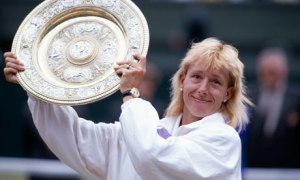
Martina Navratilova. Winner on-court, missed out on endorsements off-court. Source: The Guardian.
Bisexual female and lesbian tennis players have also had to overcome homophobia on the tour. Mauresmo had to withstand not-very-subtle ‘plays like a man’ critiques in 1999 from other players like Martina Hingis and, in a lapse of judgment, Lindsay Davenport. But, and this is the important part, both were forced to apologise. In that same year, US player Alexandra Stevenson’s mother commented during Wimbledon that her daughter needed to be protected from “lesbians in the locker-room”. This time around, Davenport was on the right side of the debate, and called the comments out as bizarre and ignorant.
In short, the very existence of openly lesbian players has brought forward the arguments around homosexuality, on court and in the stands, and those arguments have been won – at least on the women’s tour. King, and Navratilova, and Mauresmo, and others, have had to fight these battles, and have eventually emerged victorious, together with the help of allies (some of whom themselves needed to be educated).
Which brings me to my almost prosaic conclusion: no gay or bisexual male player has come out in the open era because none have chosen to take on that fight. For whatever reason, as individuals – not just tennis players, but humans – each man has decided that taking on that battle, with at least some attendant personal cost, is not in their own interest. That is an understandable conclusion for an individual to arrive at, separately.
Even so, as each year brings more players onto the tour, it brings us closer to the point where a player (or multiple players) will look at those same factors, and reach the opposite view. Surely we cannot be too many years away from a male tennis player casually talking about his boyfriend in a post-match interview, releasing a statement that he and his husband have had a child together, or even going to the Wimbledon Winners’ Ball together (which would be a pretty awesome way to come out, come to think of it).

Casey Dellacqua. Where is our male equivalent? Source: Sydney Morning Herald
For this tennis-mad LGBTI activist, I hope that day is not too far away. Not just because it would add to the already long list of same-sex attracted tennis players to look up to but, if Australian singles players continue to under-perform at home as they have done in the recent past, having an openly gay or bisexual male player might give me someone to barrack for in the second week of the next Australian Open.
UPDATE 18 January 2016:
With this year’s Australian Open starting today, I thought I would take a look back on this post, to see what has changed during the past two years. The answer is: lots, and not very much at the same time.
Australian tennis has rediscovered what it is like to have players reach the Australian Open quarter-finals, with Nick Kyrgios achieving the feat last year (2015), and he and Bernard Tomic possibilities to do so again this year and into the future.
Amelie Mauresmo continues to break down barriers, this time as coach, since June 2014, of men’s world number 2 Andy Murray.
The ‘ageing’ trend amongst the male tour might finally be on the cusp of slowing down, and eventually reversing. While the upper echelon remains, for now at least, older than any generation in memory (the only player under the age of 28 inside the current top ten is Kei Nishikori, and even he is 26), there is a large group of new young players who appear of the cusp of breaking through.
Nick Kyrgios (ranked 30) and Thanasi Kokkinakis (ranked 86) have youthful company inside the top 100 with Borna Coric, Hyeon Chung and Alexander Zverev (currently ranked 40, 51 and 83 respectively), and look likely to be joined by Karen Khachanov, too.
While I wrote in the original post that older players might stand more chance of coming out on their own terms, it is also possible that this new generation of players will shake things up in more ways than just their on-court play.
The past few years have also seen an acceleration of the welcome trend for currently-active male professional athletes to come out as either gay or bisexual. Most prominently Michael Sam came out as gay just two weeks after my original post, with Jason Collins also becoming the first openly gay man to play in the NBA that same month (having come out publicly the previous year). They have been joined by male athletes across a wide range of sports, including New Zealand Olympic rower Robbie Manson and US Winter Olympic freestyle skier silver medallist Gus Kenworthy, among others.
Of course, one thing that hasn’t changed is that there remains no out gay or bisexual male tennis players. That is a fact that still astounds me. I had thought, when writing the original post, that it was only a matter of months, or potentially just a year or two, before a player would finally break down that particular closet door.
Perhaps the culture of the men’s tennis tour is more homophobic than it appears from the outside. Perhaps there are other factors that have not been identified or considered. We probably won’t know for sure until a male player does finally come out (and even then only if they choose to discuss such things). In the meantime, the wait for an openly gay or bisexual male tennis player continues.
*It is an extraordinary, and extraordinarily awful, achievement that someone who has won 24 Grand Slam singles titles could, through years of expressing hateful and discriminatory comments, be better known as a bigot than a former champion.
